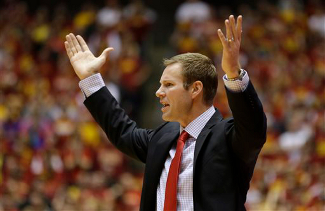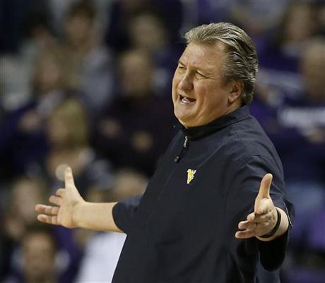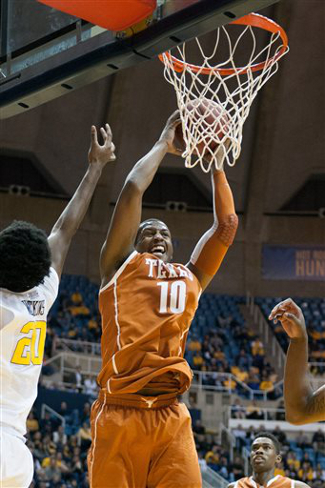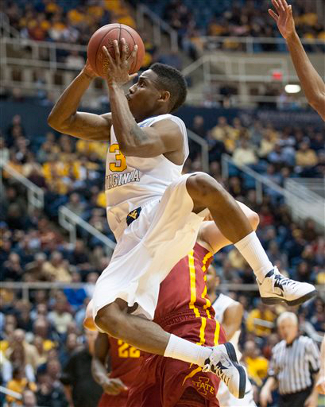#15/18 Texas Longhorns (18-4 overall, 7-2 Big 12) at Kansas State Wildcats (15-7, 5-4)
Bramlage Coliseum | Manhattan, KS | Tip: 12:45 P.M. CT
TV: Big 12 Network (Affiliate list)/ESPN Full Court/ESPN3
The Texas Longhorns have hit the halfway point of the conference season, sitting in a comfortable position as they head down the homestretch towards March. In his latest projections, ESPN’s Joe Lunardi has pegged the Longhorns as a 5-seed, slotted 17th overall on his S-curve. Although the Big 12 is a very deep league and every game is a challenge, it would take a monumental meltdown for Texas to miss the tournament at this point.
Of course, there’s now also the additional goal of a Big 12 title. With Kansas one game ahead of Texas and three games ahead of Oklahoma and West Virginia, it’s already turned into essentially a two-team race. KU enjoys one of the nation’s best home-court advantages, while the Longhorns still have to tackle the league’s toughest road tests, so the odds are heavily in favor of the Jayhawks. Still, everything about this Texas season has been surprising, so battling Kansas down to the wire for a league title would fit perfectly into the crazy narrative.
The first of those tough road tests comes today for Texas, as the team travels to Manhattan to take on Kansas State. The Longhorns have lost in their last three trips to Bramlage Coliseum, but they aren’t alone in their struggles in the Little Apple. Over the last two seasons, the Wildcats are 12-1 at home against conference foes.
By the numbers
Kansas State’s calling card under head coach Frank Martin was always its defense and its toughness on the offensive glass, and those two qualities have carried over into the Bruce Weber era. This year’s Kansas State squad is currently ranked 13th in the country in adjusted defensive efficiency, allowing just 0.931 points per possession.
The Wildcats do a great job extending pressure, and they position themselves well off from the ball to discourage passes. They work together very well as a unit, shading over to help off of their own man when possible and limit penetration opportunities. K-State has the nation’s 11th-best three-point defense, limiting opponents to just 28.9% from behind the arc. With that excellent perimeter pressure, sometimes the interior D is slow to react when dribble penetration gets inside. Typically, though, opponents get so frustrated by having to start their offense further out that they settle for jump shots and don’t attack that weakness.
On the other end of the court, Kansas State is not a great shooting team. Their own three-point percentage is nearly as low as the one their defense allows, with the team making just 31.4% of their long-range attempts. Last year, the Wildcats would frequently free up their shooters for 15 to 18-foot jump shots coming off of curls. This year, there is more spreading of the floor, and the motion away from the hoop doesn’t normally result in canned jumpers. Instead, the Wildcats are patient enough to let their movement and motion throw the defense off-balance for just a second, then attack with their quick guards or hit their dominant big man in great post position.
When Kansas State does settle for jump shots, their excellent offensive rebounding makes up for the misses. The Wildcats have reclaimed 35.6% of their missed shots, with many of those offensive boards coming in the form of short, weakside rebounds that lead to easy putbacks. Although it’s become cliché to say that K-State’s best offense is missed shots, that’s still accurate this season.
Meet the Wildcats
The player that Texas fans already know very well is Cedar Hill product Thomas Gipson (No. 42), a tank of a man that performed well against his home-state Longhorns in their last meeting. When these two teams squared off on January 21st, Gipson dominated Texas inside, scoring 24 points on 10-of-18 shooting. He’s a very strong interior player, but still has smooth post moves, and has even started working on a mid-range jumper. Although he prefers living on the blocks, that extra little wrinkle to his game has made him even tougher to gameplan for.
On the perimeter, the addition of freshman point guard Marcus Foster (No. 2) has given the Wildcats another weapon. Hailing from Wichita Falls, Foster has a very quick first step, allowing him to blast right through the cracks in the defense when K-State’s perimeter passing shifts opponents from side-to-side. On a team that isn’t very accurate from long range, his three-point shot is one of the best, and he doesn’t need much time or space to get it off.
Joining him in the backcourt is senior Will Spradling (No. 55), a spot-up shooter who has seen his three-point accuracy decrease during his time in Manhattan. After knocking down 37% of his threes during a solid freshman campaign, the word got out about Spradling, and he has found it tougher to get space on the perimeter. This year, he’s only knocked down 34.4% of his threes, but is still dangerous when he camps out in the corner and the other K-State guards start driving to the rack.
The team’s best shooter is its do-everything senior Shane Southwell, a 6’7″ player who can handle the rock, bang inside against bigger opponents, knock down jumpers with little space, and find teammates for open looks. Southwell is very accurate with his mid-range shot, but even when he has a good look, he’s ready to defer to teammates. When opponents scramble to challenge his shot, Southwell frequently passes up the opportunity and makes laser-like feeds to the post after he’s already airborne. His 23.4% assist rate is actually tops among the team’s starters, and ranks him just inside the Top 300 nationally.
Rounding out the starting five is a second freshman, Wesley Iwundu (No. 25). With both Iwundu and Southwell checking in at 6’7″, the Wildcats have a lot of length on defense, and Iwundu is constantly frustrating opponents on the perimeter. On offense, he’s a good slasher and can get to the rim in just a few seconds, but that isn’t his primary role in the KSU game plan.
Although Iwundu doesn’t usually shoot the three, he’s made 5-of-11 on the year, and his long-range bombs were a big reason why the Wildcats knocked off Oklahoma at home last month. At this point, his biggest weakness on offense is an inability to read the situation, which leads to him overplaying his hand and turning it over or getting called for a charge. With great driving ability and a good outside shot already in his repertoire, once the freshman can add in a pull-up jumper and a floater, he’s going to be a nightmare to contain.
The best option off the bench for the Wildcats is freshman guard Jevon Thomas (No. 5), who joined the team at midseason after eligibility issues were finally cleared up. Like Foster, he is an incredibly quick guard with excellent driving ability, but he is always looking to set up his teammates to score. His ability to find seams in the defense, attack with the bounce, and draw defensive attention is key on an offense that can sometimes stagnate.
The Wildcats also get contributions from Nino Williams (No. 11), D.J. Johnson (No. 50), and Omari Lawrence (No. 12). Williams is a 6’5″ wing, but he is a fantastic rebounder, especially crashing the offensive glass. Johnson has proven to be a serviceable backup for Gipson, although he doesn’t have the same post skills and tends to get called for offensive fouls when trying to set high ball screens. Lawrence is a senior who has never played major minutes, and is only averaging about 11 per game this year.
Keys to the game
1) Make Gipson work for his points – The K-State big man is very hard to slow down, but he completely manhandled the Longhorns in the paint just a few weeks ago. The Texas bigs need to prevent him from getting such deep post position this afternoon, and they cannot fall for his very good shot fakes near the rim. Giving up another 24 points to Gipson in Manhattan would make a road win very difficult.
2) Eliminate penetration from the guards – Keeping Foster and Thomas from driving into the heart of the defense will take away a huge piece of the Kansas State offense, but that’s easier said than done. K-State’s quick ball movement exposes gaps in opposing defenses, so it will take a team effort for the Longhorns to keep dribble penetration to a minimum. If they can do it, though, the Wildcats will likely have to knock down jumpers, something that they have struggled to do this season.
3) Strong presence on the glass – Although Texas has done a very good job rebounding the ball this season, the Horns struggled on the defensive glass against Kansas State in Austin. The Wildcats won back 43.2% of their misses in the first game, erasing Texas’ good defensive possessions with second and third chances. If Texas wants to end its losing streak at Bramlage Coliseum, the team has to close out defensive stops with solid rebounding not just from the bigs, but the wings, as well.
|














